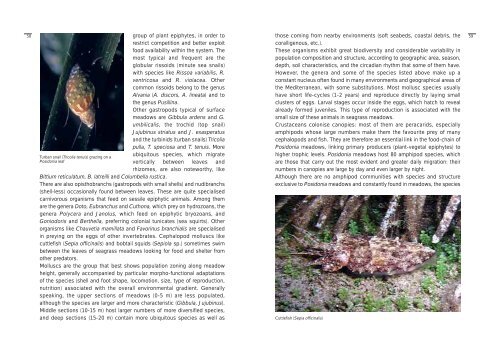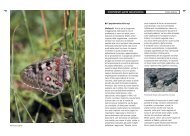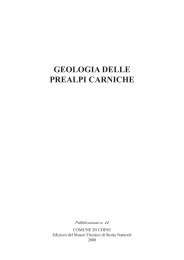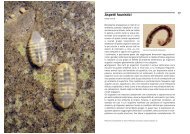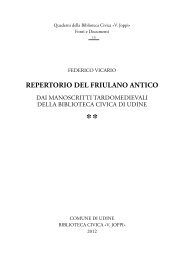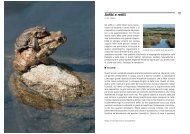Fauna: invertebrates - Udine Cultura
Fauna: invertebrates - Udine Cultura
Fauna: invertebrates - Udine Cultura
Create successful ePaper yourself
Turn your PDF publications into a flip-book with our unique Google optimized e-Paper software.
group of plant epiphytes, in order to<br />
restrict competition and better exploit<br />
food availability within the system. The<br />
most typical and frequent are the<br />
globular rissoids (minute sea snails)<br />
with species like Rissoa variabilis, R.<br />
ventricosa and R. violacea. Other<br />
common rissoids belong to the genus<br />
Alvania (A. discors, A. lineata) and to<br />
the genus Pusillina.<br />
Other gastropods typical of surface<br />
meadows are Gibbula ardens and G.<br />
umbilicalis, the trochid (top snail)<br />
Jujubinus striatus and J. exasperatus<br />
and the turbinids (turban snails) Tricolia<br />
pulla, T. speciosa and T. tenuis. More<br />
ubiquitous species, which migrate<br />
vertically between leaves and<br />
rhizomes, are also noteworthy, like<br />
Bittium reticulatum, B. latreilli and Columbella rustica.<br />
There are also opisthobranchs (gastropods with small shells) and nudibranchs<br />
(shell-less) occasionally found between leaves. These are quite specialised<br />
carnivorous organisms that feed on sessile epiphytic animals. Among them<br />
are the genera Doto, Eubranchus and Cuthona, which prey on hydrozoans, the<br />
genera Polycera and Janolus, which feed on epiphytic bryozoans, and<br />
Goniodoris and Berthella, preferring colonial tunicates (sea squirts). Other<br />
organisms like Chauvetia mamillata and Favorinus branchialis are specialised<br />
in preying on the eggs of other <strong>invertebrates</strong>. Cephalopod molluscs like<br />
cuttlefish (Sepia officinalis) and bobtail squids (Sepiola sp.) sometimes swim<br />
between the leaves of seagrass meadows looking for food and shelter from<br />
other predators.<br />
Molluscs are the group that best shows population zoning along meadow<br />
height, generally accompanied by particular morpho-functional adaptations<br />
of the species (shell and foot shape, locomotion, size, type of reproduction,<br />
nutrition) associated with the overall environmental gradient. Generally<br />
speaking, the upper sections of meadows (0-5 m) are less populated,<br />
although the species are larger and more characteristic (Gibbula, Jujubinus).<br />
Middle sections (10-15 m) host larger numbers of more diversified species,<br />
and deep sections (15-20 m) contain more ubiquitous species as well as<br />
those coming from nearby environments (soft seabeds, coastal debris, the<br />
coralligenous, etc.).<br />
These organisms exhibit great biodiversity and considerable variability in<br />
population composition and structure, according to geographic area, season,<br />
depth, soil characteristics, and the circadian rhythm that some of them have.<br />
However, the genera and some of the species listed above make up a<br />
constant nucleus often found in many environments and geographical areas of<br />
the Mediterranean, with some substitutions. Most mollusc species usually<br />
have short life-cycles (1-2 years) and reproduce directly by laying small<br />
clusters of eggs. Larval stages occur inside the eggs, which hatch to reveal<br />
already formed juveniles. This type of reproduction is associated with the<br />
small size of these animals in seagrass meadows.<br />
Crustaceans colonise canopies: most of them are peracarids, especially<br />
amphipods whose large numbers make them the favourite prey of many<br />
cephalopods and fish. They are therefore an essential link in the food-chain of<br />
Posidonia meadows, linking primary producers (plant-vegetal epiphytes) to<br />
higher trophic levels. Posidonia meadows host 80 amphipod species, which<br />
are those that carry out the most evident and greater daily migration: their<br />
numbers in canopies are large by day and even larger by night.<br />
Although there are no amphipod communities with species and structure<br />
exclusive to Posidonia meadows and constantly found in meadows, the species<br />
58 59<br />
Turban snail (Tricolia tenuis) grazing on a<br />
Posidonia leaf<br />
Cuttlefish (Sepia officinalis)


